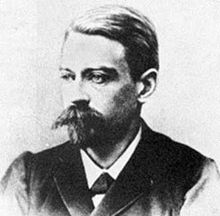
$$S(\mu)(z)=\int_a^b\!\frac{\mu(dx)}{z-x}=\cfrac{c_0}{z-a_0-\cfrac{\lambda_1}{z-a_1-\cfrac{\lambda_2}{z-a_2-\cfrac{\lambda_3}{\cdots}}}}$$
$$\int_a^b\!g(x)\,\mu_F(dx)=g(b)F(b^+)-g(a)F(a^-)-\int_a^b\!g'(x)F(x)\,dx.$$
``La vie scientifique de Tchébicheff a été glorieusement remplie, et dans la complète mesure de ses rares facultés, du don de l'invention qu'il avait à un si haut degré. Ses découvertes profondes, originales, laisseront dans l'analyse une trace impérissable, à l'éternel honneur de la science russe. De lui, je ne puis m'empêcher de rapprocher Stieltjes, enlevé prématurément dans tout l'éclat de son talent, après avoir produit son admirable mémoire sur les fractions continues algébriques. J'étais dans la confiance de ses recherches, nous étions étroitement liés, et sa dernière lettre me faisait part de la joie qu'il avait ressentie d'être nommé correspondant de l'Académie de Saint-Petersbourg. Cette profonde satisfaction a été son dernier bonheur, et un adoucissement à ses souffrances, lorsque ses jours étaient comptés, et qu'il sentait la mort venir. Hélas, Monsieur, tous mes amis s'en vont, la plupart de ceux dont j'ai partagé les travaux m'ont quitté, mais l'éternelle séparation ne peut m'empêcher qu'ils me soient présents, je reste fidèle à mes souvenir, et je garderai toujours la mémoire de Tchébicheff et de Stieltjes.'' Lettre de Ch. Hermite à A. Markoff (8 mai 1895), in H. Ogigova, Les lettres de Ch. Hermite et A. Markoff 1885-1899, Revue d'Histoire des Sciences et de leurs applications, Presses Universitaires de France, tome XX, n°1, janvier-mars 1967, p. 25-26.
Note : Pafnuty Lvovich Chebyshev (Tchébicheff) (Okatovo 1821 - Saint-Petersbourg 1894) était en relation avec Charles Hermite (Dieuze 1822 - Paris 1901) depuis 1852. Ce dernier fut élu membre honnoraire de l'Académie des Sciences de Saint-Petersbourg en 1895, et Thomas Jan Stieltjes (Zwolle 1856 - Toulouse 1894) membre correspondant en 1894. Andrei Andreyevich Markov (Markoff) (Ryazan 1856 - Saint-Petersbourg 1922) fut un élève de Chebyshev, et contribua à l'étude des fractions continues. Vers l'âge de cinquante ans, il proposa le concept de chaînes (de Markov !) pour étudier un problème de linguistique. Andrei Andreyevich Markov avait un frère mathématicien (Vladimir), et un fils mathématicien, bien connu, et homonyme !
Culture : ceux qui pensent que les fractions continues sont des vieilleries poussiéreuses et inusitées se trompent. Les approximants de Padé sont utilisés des milliards de fois par jour dans les ordinateurs ! Henri Padé (Abbeville 1863 - Aix-en-Provence 1953) fut un élève de Ch . Hermite. Les fractions continues ont mené Stieltjes à l'étude du problème des moments, à la transformée de la mesure et à l'intégrale qui portent son nom, aux formules de quadratures des polynômes orthogonaux, et Hermite à la preuve de la transcendance de $e=1+1/1!+1/2!+1/3!+\cdots$.
$$f_1(x) = \exp_{[1,0]} = 1 + x$$
$$f_2(x) = \exp_{[1,1]} = \frac {1 + \frac 12x}{1 - \frac 12x}= 1 + \frac x{1 - \frac 12x}$$
$$f_3(x) = \exp_{[2,1]} = \frac {1 + \frac 23 x + \frac 16 x^2}{1 - \frac 13x} = 1 + \frac x{1 - \cfrac{\frac 12x}{1 + \frac 16x}}$$
Références :
- Roger Huron
Le destin hors série de Thomas-Jan Stieltjes (1856-1894) - Articles de Stieltjes sur numdam.org
- Charles Hermite et T.-J. Stieltjes
Correspondance, avec une préface d'Émile Picard
Gauthier-Villars (1905) - Gérard Letac
Stieltjes à Toulouse: problème des moments et résonances contemporaines - T.-J. Stieltjes
Sur les fractions approchées d'une fonction par des fractions rationnelles